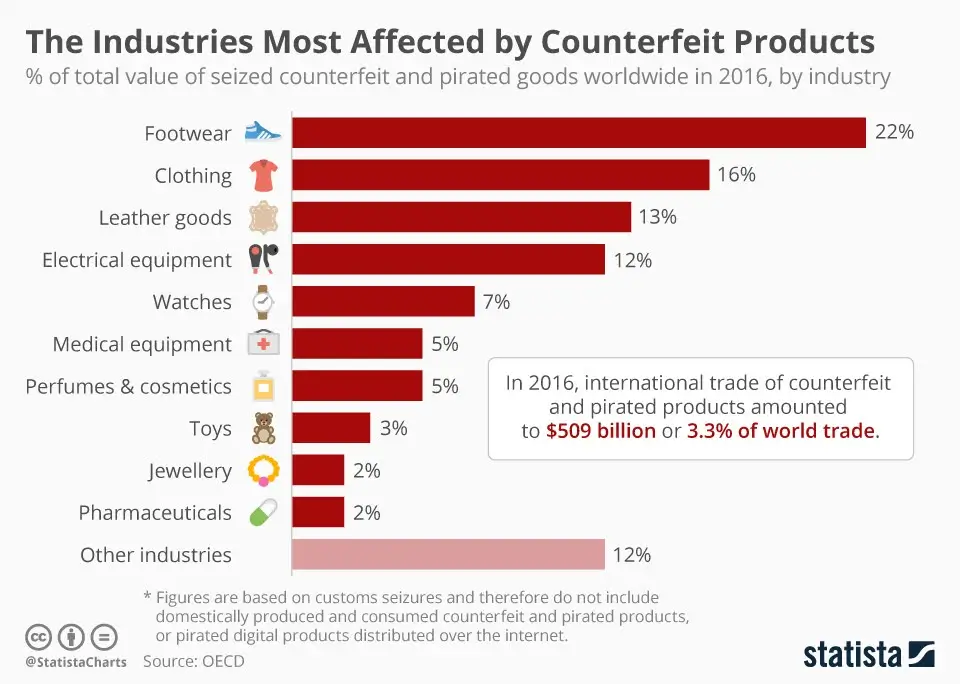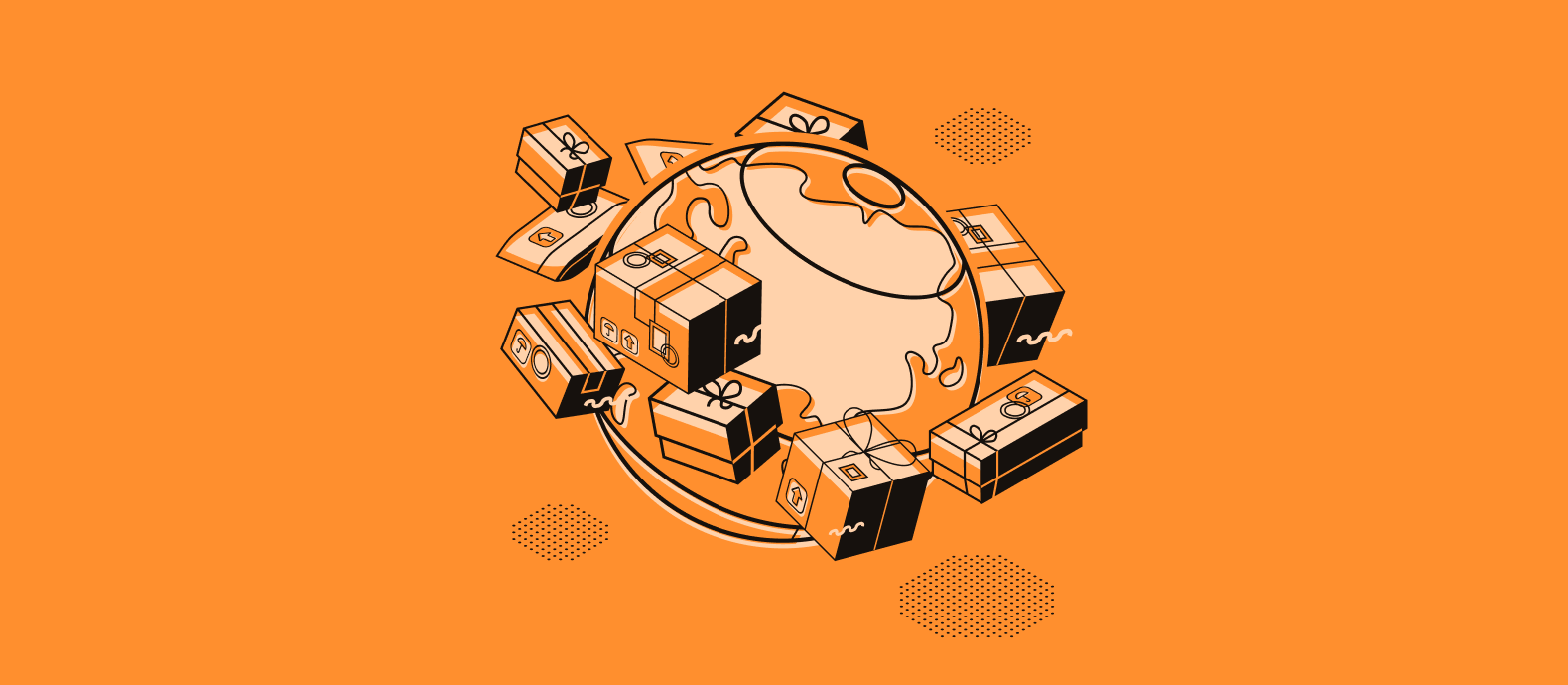This article looks at the wider economic impacts caused by high levels of counterfeiting, and how these impacts negatively affect all levels of society.
The potential for physical harm to consumers, accidental or intentional, of counterfeit goods is clear. The results can be devastating, heartbreaking, and even fatal. The physical dangers of counterfeits have been covered in previous Red Points articles. Similarly, the damage counterfeiting causes to legitimate brands is unquestionable. This analysis looks instead at the broad national and global economic impacts of this illegal industry, and attempts to bring light to the range of harms caused by illegal counterfeiting.
Lost tax revenue and economic activity
A key reason society suffers from the presence of counterfeiting is the lost potential tax revenue. A group of people working within a sector of organized crime such as counterfeiting is extremely unlikely to declare earnings of their illegal enterprise to the government.
The amount of sales tax that the world’s nations lost to counterfeiting in 2022 was $171 billion. This is money that could be going into hospitals, roads, and schools in order to keep citizens healthy, facilitate economic growth in a country, and promote education and future innovation, but it instead finds itself in the hands of criminal organizations.
Counterfeits support the wider black market
Another effect of counterfeit goods is that consumers unknowingly support criminal enterprises. Organized criminal groups very rarely operate in isolation, successful ones typically have the support of other groups providing an array of illegal services. Expansive criminal networks are formed that offer numerous services and products illegally, helping to uphold and protect interconnected criminality worldwide. Counterfeiting especially has a close connection to other forms of criminality, in large part due to the organization and network support required to sustain these operations.

For example, Interpol led Operation Crete II in 2024 which seized $225 million in counterfeit goods in South America and led to 104 arrests. Police in multiple countries were able to dismantle criminal organizations that were involved in much more than counterfeiting, including forgery and money laundering.
A large portion of the seizure was pharmaceutical drugs that can be used to manufacture illicit drugs. Police also seized counterfeit cigarettes in Brazil, fake jewelry in Chile, unregulated alcohol in Ecuador, and fabrication materials for fake shoes in Paraguay. The producers of fake products don’t just live off the profits peacefully but often engage in more serious criminal acts.
Lost genuine employment
The effects of counterfeiting are not just seen in annual financial reports and through tax estimates. Direct negative effects are experienced by a huge amount of people, and loss of employment is one of the most disruptive things that can happen to an individual.
According to the EUIPO, the EU is losing 200,000 jobs each year in the clothing, cosmetics, and toy industries alone. Looking at the global level, Frontier Economics estimated net job losses to be between 4.2 and 5.4 million due to counterfeiting in 2022.
While the people previously occupying these jobs go out to look for new employment, some fail to find any type of new employment. Many of the luckier ones who manage to land a replacement job find themselves earning noticeably less than before. Finally, many workers, upon losing legitimate employment, elect to join the counterfeiting industry in search of employment, an industry functioning without regulations, workers’ rights or safety protocols.
Counterfeiting discourages innovation
Having a system of IP that is not protected and upheld by the government means there is a greatly reduced benefit to creating new goods. If simply reproducing the designs of others and undercutting them on price is permitted, or at least easy to get away with without fear of punishment, then people are incentivized to infringe on IP, instead of designing creative new products.
The story of Aaron Muderick, founder of Crazy Aaron’s Puttyworld, is a prime example. Muderick created a popular magnetic putty that is safe and follows all federal standards for toys for children. However, he has dealt with a wave of counterfeiters in online marketplaces that don’t follow compliance laws.
In 2021, Muderick testified at a U.S. Senate Committee on Judiciary hearing that the infringing products had high-strength magnets not approved for children’s toys. This puts children at risk if they play with the fake putty.
Muderick’s testimony also highlighted how difficult it was for him to take control of the situation. Marketplace platforms were reactive and not proactive in keeping fakes out, and Muderick’s company spent valuable resources trying to get counterfeit toys taken down. Overall, the lack of IP protection is a terrible influence on society and the economy, making everyone, not just the inventor, net losers.
Lost foreign investment
Higher levels of counterfeiting in a country have a clear detrimental effect on foreign investment. Companies operating in IPR-sensitive industries, that is to say, sectors that are influenced greatly by the presence of counterfeiting, are especially deterred from investing in countries with poor IP enforcement.
A paper published by the National Bureau of Economic Research measures the impact of counterfeiting on foreign investment by the drop in exports. The research looks specifically at industries that are particularly sensitive to changes in IP rights in countries with high levels of counterfeiting. The resulting reduction in investment due to counterfeiting is estimated at $111BN annually, or a 5% reduction in exports from these countries and sectors. The same study found that nations can expect to see a 20% increase in exports by enforcing IP rights more strictly.
Similarly, a paper called The Impacts of Counterfeiting on Corporate Investment by Alexander Cuntz and Yi Qian found an overall negative effect of counterfeit goods on research and development across sectors.
The reasons for this are clear. What company wants to spend money on research and development, design, manufacture, etc, if they know that any new products they develop and manufacture are going to be ripped off by counterfeiters, with no response or protections from governing bodies?
Staying safe against counterfeiting
The impacts of counterfeiting are clearly negative, and strong actions against the industry need to be taken sooner rather than later. The growth is staggering: the global value of counterfeiting is expected to grow to $1.77 trillion by 2030. As this illegal production continues, the consequences discussed in this article will only become more compounded and affect more people in a more tangible way. It’s important for people to be aware, not only of the counterfeiting trade itself, but the ripple effects it causes, corrupting and damaging all levels of society as it becomes a larger force in the world.







